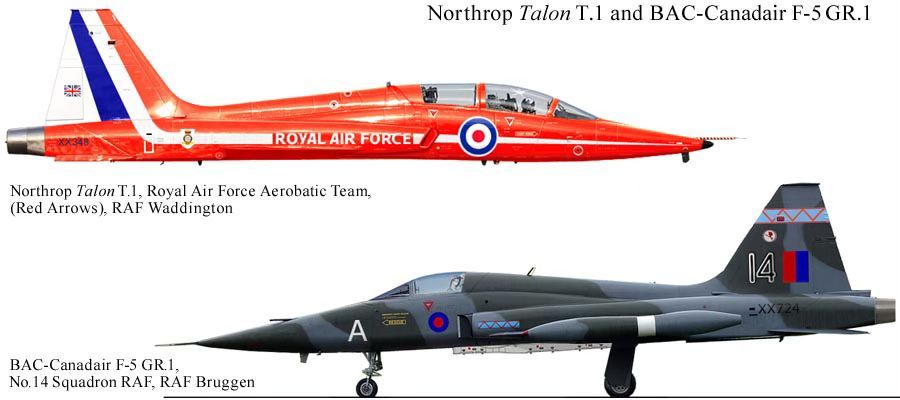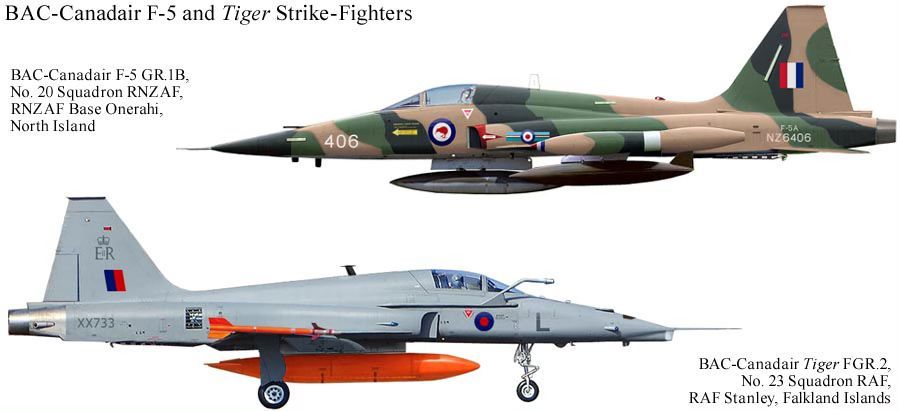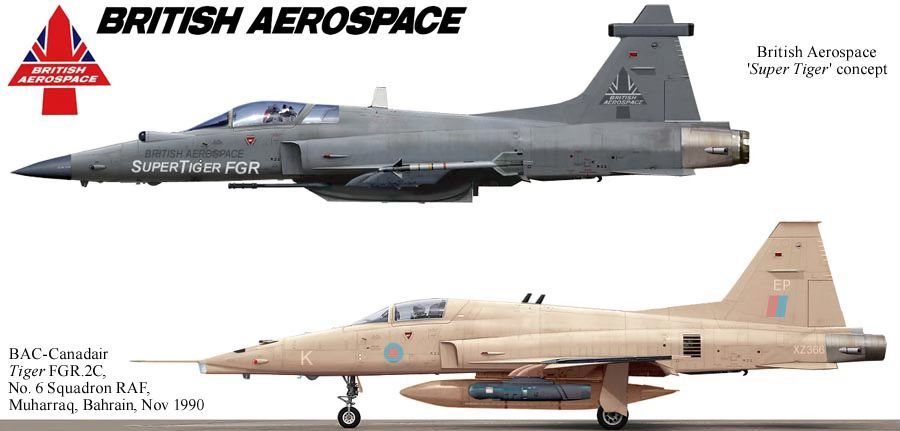Royal TigersIn the early 1960s, Air Staff Target 362 for an advanced supersonic jet trainer to replace the Folland Gnat T1 and Hawker Hunter T7, was announced. At the time it was hoped that the broadly similar French requirement, the École de Combat et d'Appui Tactique, ECAT "tactical combat support trainer") for a cheap, subsonic dual role trainer and light attack aircraft to replace the Fouga Magister, Lockheed T-33 and Dassault Mystère IV might be merged with the British requirement and thus allow a combined development/acquisition.
Alas, this was not to be. In 1968, Defence Secretary Denis Healey, announced that, in addition to the General Dynamics F-111K strike aircraft then on order and in production, the Government would acquire some 35 Northrop T-38 Talon supersonic jet trainers. These would shortly thereafter also be complimented by 165 F-5A light fighters. The latter would actually be the same configuration to the Canadian CF-5 aircraft then entering service and would be produced jointly by British Aircraft Corporation (BAC) and Canadair. The first T-38s and F-5 GR.1s would enter RAF service in 1971.
In early 1973, the contract with BAC and Canadair the F-5s would be amended after only 57 F-5 GR.1s had been delivered. With Northrop having flown the first of a new variant, the F-5E, the previous year, the decision was made to change the requirement to this much more improved variant. The remainder of the order would be now delivered to this new configuration and, adopting the new Tiger II moniker, would be known as Tiger FGR.2s, or more colloquially, as “Royal Tigers”. Moreover, those F-5 GR.1s already in service would soon be on-sold to other operators such as Malaysia, New Zealand and even Ireland. In their place, RAF original numbers would be made up with more Tiger FGR.2s. The Tiger FGR.2s would be unique in adding a a Ferranti ARI23231 Laser Ranging and Marked Targeting System (LRMTS) in a nose faring below the Emerson Electric AN/APQ-153 nose radar.
Concurrent to this, the Canadian Air Force Air Defence Command, also acquired the same version, designating it the CF-151. These would gradually replace the earlier CF-116s during the 1970s and continue the production lines going in both Canada and Great Britain. Versions would also enter service elsewhere in the Commonwealth, with Australia (24 FGR.2s alongside 64 T-38s acquired directly from the USA in kit form and assembled locally by GAF), New Zealand (originally 14 F-5 GR.1s were acquired, but these and the RNZAF A-4Ks were all replaced with Tiger FGR.2s in the early 1980s), Malaysia (18 supplementing/replacing the 18 early F-5 GR.1s) and India (145 Tiger FGR.2s alongside 88 T-38s acquired directly from the USA in kit form and assembled locally by HAL).
In RAF service the Tiger FGR.2s would serve through to 2007 and undergo multiple upgrades. They were beloved by their crews as being a simple but highly effective combat platform. Alongside the main training and combat units, the T-38 would also serve with the RAF’s Red Arrows Aerobatic Team.
Evolution of the BAe 'Super Tiger' ProjectWhen US President Jimmy Carter vetoed the F404-powered F-5G proposal for Taiwan in October 1978, it seemed that Northrop's single-engined F-5 project was dead. This was a major impetus for BAe Warton to pursue their RB.199-powered design for the RAF. And the prospect of export sales was not lost on BAe brass either. To date, Tiger exports had been limited to ex-RAF airframes. The proposed 'Super Tigers' were to be new-builds with considerably more British technological content.
Compared with the in-service Tiger FGR.2, the 'Super Tiger' forward fuselage and wing structures would be essentially similar. However, to enhance performance as a fighter, a search radar - the Ferranti Blue Falcon - would be installed in the nose along with a Marconi IRST 'ball'. The leading edge extensions were also to be substantially increased in size. However, it was the rear fuselage and engine bay where the biggest changes would be made.
While the tailplane remained unchanged, the rear fuselage itself was entirely altered to accommodate a single Turbo-Union RB.199-104F turbofan engine. This engine had been chosen for parts/maintenance commonality with the RAF's Tornado GR.1s but it was also somewhat more compact than the American F404 turbofan which Northrop had been studying. All of these features went over quite well when presented to the MoD and RAF.
One recommended change was in armament arrangement. The RAF had never been completely happy with the US-designed M39 cannons - or their tendency to blind pilots when fired in low-light conditions. It was preferred that the fixed armament be removed from the forward fuselage and repositioned lower down. As BAe had been in the process of designing a 30 mm Aden gun pack for the Hawk trainer, this was suggested as starting point. For the 'Super Tiger', this pod would double as a central pylon.
After some discussion, it was decided to design this pod/pylon from scratch around the new Mauser BK27 gun. That weapon - designed for the Tornado - was optimised for air-to-ground fire (whereas the 30 mm Aden had been air-to-air optimised). The BK27's 27x145 mm was substantially larger than the old M39's 20x102mm round. So, even a single BK27 had a heavier weight of fire than the paired 20s. For a degree of compactness, the BK27 was to lie on its side within the pod/pylon.
In the end, all of this design effort was for naught. When US development of its F-5G resumed, the 'Super Tiger' was regarded as a potential threat to Northrop export sales. This brought out that corporation litigious nature which forced BAe to abandon its 'Super Tiger' programme. In turn, the RAF dropped its light strike requirement and focused exclusively upon the larger Tornado GR.1.
 Top: A Northrop Talon T.1 of the Royal Air Force Aerobatic Team based at RAF Waddington. The Red Arrows replaced their Folland Gnat T.1 mounts with Talon T.1s in 1972. Externally, RAF Talon T.1s differed very little from USAF Northrop T-38 supersonic trainers. Red Arrows aircraft were standard T.1s other than the dye tanks and tubes installed for the aerobatic smoke oil system.
Top: A Northrop Talon T.1 of the Royal Air Force Aerobatic Team based at RAF Waddington. The Red Arrows replaced their Folland Gnat T.1 mounts with Talon T.1s in 1972. Externally, RAF Talon T.1s differed very little from USAF Northrop T-38 supersonic trainers. Red Arrows aircraft were standard T.1s other than the dye tanks and tubes installed for the aerobatic smoke oil system.
Bottom: A BAC-Canadair F-5 GR.1 of No 14 Squadron RAF at RAF Bruggen in 1973. This aircraft is on exchange with the Canadian Armed Forces at the Air Weapons Training Installation at Decimomannu AB on Sardinia. This explains the temporary tail markings and the CBLS (Carrier, Bomb, Light Store) mounted for armaments practice. Note that, while at the AWTI, XX724 carried the usual tip tanks but no wing pylons were fitted. Top: A BAC-Canadair F-5 GR.1B of No. 20 Squadron RNZAF. All Kiwi F-5s were based at RNZAF Base Onerahi near Whangarei - a re-opened WW2-era facility sharing its runway with local airline traffic. Note GR.1B avionics upgrades (indicated by the antennae changes) as well as New Zealand specific mods - a larger dorsal safety beacon and the addition of 'slime lights' for formation flying.
Top: A BAC-Canadair F-5 GR.1B of No. 20 Squadron RNZAF. All Kiwi F-5s were based at RNZAF Base Onerahi near Whangarei - a re-opened WW2-era facility sharing its runway with local airline traffic. Note GR.1B avionics upgrades (indicated by the antennae changes) as well as New Zealand specific mods - a larger dorsal safety beacon and the addition of 'slime lights' for formation flying.
NZ6406 is seen here carrying three drops tank plus the standard pair of tip tanks. Such a load would only be carried if No. 20 Squadron aircraft were about to hop across the Tasman to fulfill their spoofing role at HMAS Albatross near Nowra, NSW.
Bottom: A No. 41 Squadron RAF BAC-Canadair Tiger FGR.2 detailed to the Falklands-based 'TigDet'. First operated from RAF Stanley (PSY), in April 1986, the Tigers were assigned to No. 1435 Flight RAF. As a mixed unit, 1435 Tigers joined up with Phantoms (detached from No. 23 Squadron) at the newly-opened RAF Mount Pleasant field.
Tiger FGR.2 XX733 is seen here in its new, grey 'Falklands Finish' paintwork. [1] Individual markings were applied in Dark Grey - including a Royal cipher (standing in for 41 Squadron's assigned 'ER' code). For its long, inbound flight from Ascension Island Base, this Tiger was fitted with an IFR probe and had a day-glo finish applied to its centreline tank - and even to its wingtip Sidewinder missiles. Once 'in country', the probe would be removed and day-glo items swapped for drab alternatives. [2]
_______________________________________________________
[1] A similar medium-grey scheme would become standard by the mid-1990s but, a decade earlier, it was distinct to Falklands-based fighters.
[2] The day-glo tanks and refuelling probes were returned to Ascension aboard returning Hercules C1(K) tankers for re-use with the next 'Falklands Shuttle' of Tigers. Bottom: A BAC-Canadair Tiger FGR.2C of No. 6 Squadron, RAF, based out of Muharraq, Bahrain, during the Gulf War. After a tough sortie, this Tiger has regained Muharraq with all weapons gone - including Sidewinder self-defence missiles. On return, only the FGR.2C's centreline drop tank and an AN-AAQ-14 LANTIRN targeting pod (on its inboard, portside pylon) are retained.
Bottom: A BAC-Canadair Tiger FGR.2C of No. 6 Squadron, RAF, based out of Muharraq, Bahrain, during the Gulf War. After a tough sortie, this Tiger has regained Muharraq with all weapons gone - including Sidewinder self-defence missiles. On return, only the FGR.2C's centreline drop tank and an AN-AAQ-14 LANTIRN targeting pod (on its inboard, portside pylon) are retained.
Like all Tigers involved in Operation Grandby, XZ366 had been repainted in all-over Desert Pink before leaving RAF Coltishall. Upon the return of No. 6 Squadron aircraft to their home base, all Tigers would go in for depot level maintenance checks and were repainted in the RAF's new Medium Grey camouflage scheme.
Top: An impression of the proposed BAe 'Super Tiger' - a planned, single-engined replacement for the RAF's remaining Tiger FGR.2s. For its 'Super Tiger' programme, BAe was operating in parallel with what became Northrop's F-5G/F-20 Tigershark. But the 'Super Tiger' was specifically tailored to RAF requirements. The dominant role would still be light strike - complementing the heavier Tornado GR.1 - but the 'Super Tiger' was designed to better suit the light fighter role as well.